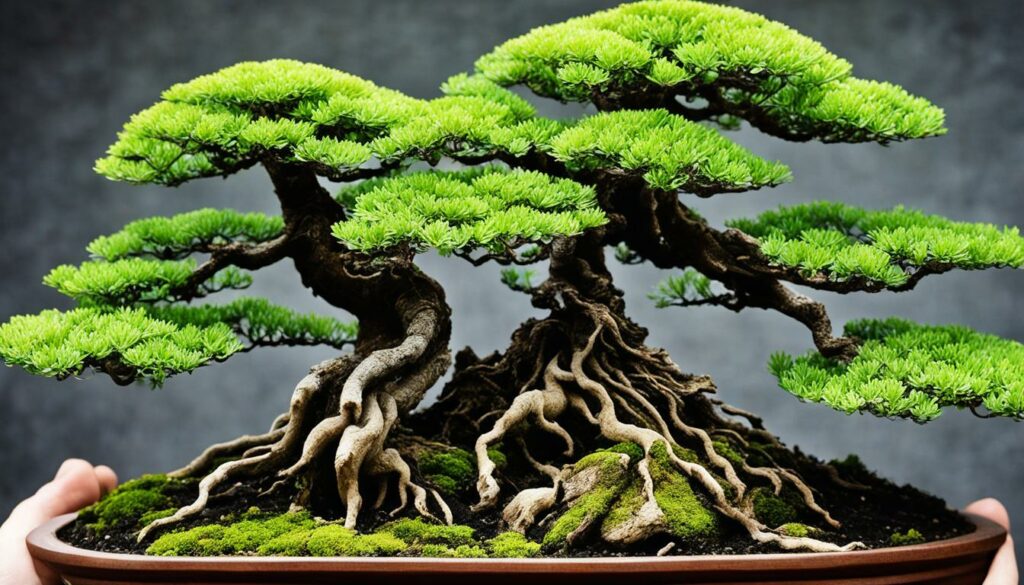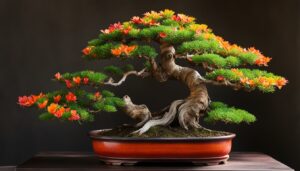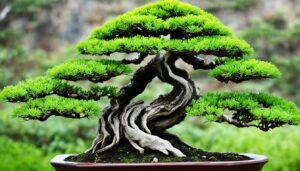Do you love a good landscape feature and have an appreciation for the intricate and delicate? Bonsai Styling Forest Planting is the art of creating a serene tabletop landscape using group planting techniques to mimic a natural forest setting. Explore the beauty of the forest style in Bonsai and learn how to create a living, breathing work of art.
If you’re new to the art of Bonsai Styling, don’t worry; this article’s got you covered. We’ll first dive into the fundamentals of bonsai styling, the history and principles of bonsai, and the different styles and techniques used to shape and train these miniature trees. From there, we’ll explore the enchanting world of forest style bonsai and guide you through the process of creating your bonsai forest landscape.
By the end of this article, you’ll have a thorough understanding of Bonsai Styling Forest Planting and how to create a visually stunning tabletop masterpiece that captures the beauty and tranquility of a natural forest.
Key Takeaways:
- Bonsai Styling Forest Planting is an art that mimics a natural forest setting using group planting techniques
- The forest style of Bonsai is a popular style that can create a cohesive and harmonious miniature landscape
- Choosing the right tree species is crucial, and understanding the unique design considerations involved will help create a serene and visually appealing forest planting
- Proper maintenance is essential to the plant’s survival, including pruning, wiring, repotting, watering, fertilizing, and preventing overcrowding
- The Bonsai community offers various resources for continued learning and inspiration
Understanding Bonsai Styling
Before you start forest planting, it’s essential to have basic knowledge of bonsai styling. Bonsai is a unique art form originating in China and Japan, in which miniature trees are grown in small containers and trained to resemble full-sized trees.
There are different styles and techniques used to shape and train the trees, and each method has its unique characteristics. Some common bonsai styles include formal upright, informal upright, slanting, cascade, and semi-cascade.
The art of bonsai involves creating a natural and harmonious aesthetic by manipulating the trees’ shape, size, and proportions. This is achieved through pruning, wiring, and repotting, which are all fundamental practices in bonsai styling.
Moreover, bonsai has a deeper significance beyond creating natural-looking landscapes; it fosters calmness, patience, and contemplation, making it an excellent hobby for those seeking relaxation and personal growth.
“Bonsai reflects the beauty and paradoxes of nature. It’s a way of seeing reality in miniature and the universe in a grain of sand.” – Juliette Levy
History of Bonsai
The practice of bonsai can be traced back to ancient China and Japan. It was initially a way of displaying rare and exotic tree specimens among wealthy individuals and nobility.
Over the years, bonsai became more accessible to the general population, and people started growing and designing their miniature trees. In the early 1900s, bonsai became popular in the Western world, and enthusiasts started experimenting with different styles, techniques, and species of trees. Today, bonsai is a global phenomenon, with enthusiasts from all over the world sharing their creations and knowledge.
Principles of Bonsai
Bonsai styling follows specific principles to create a natural and harmonious composition. One of the essential principles is maintaining the balance between the tree’s roots and its foliage. This is achieved through proper pruning, wiring, and repotting practices, which encourage compact root growth and balance foliage density.
Another critical principle in bonsai styling is achieving the tree’s natural taper, which is the gradual narrowing of the trunk from the base up. This creates a more natural-looking tree, and it is achieved through careful selection of branches and pruning.
Exploring Forest Style Bonsai
Creating a forest style bonsai is like crafting a natural forest in miniature form. In this style, multiple trees are planted together to achieve a cohesive landscape that resembles a tranquil forest. The design considerations of forest style bonsai are unique and different from other bonsai styles.
A wide variety of trees can be used in forest plantings, including conifers, deciduous trees, and even flowering trees. Generally, tree species with small and compact leaves are preferred, as they are easier to manage and can create a more immersive landscape.
One of the key aspects of forest style bonsai is creating the illusion of depth and perspective. This is achieved by varying the height and position of the trees, with the tallest trees placed towards the back of the arrangement and the shorter trees towards the front. To further enhance this effect, accent plants, rocks, and other natural elements can be added to create a multi-dimensional and immersive landscape.
Common Trees Used in Forest Style Bonsai
| Tree Species | Features |
|---|---|
| Japanese Maple | Small leaves, vibrant autumn colors |
| Pine | Conical shape, evergreen foliage |
| Juniper | Flexible branches, needle-like leaves |
| Chinese Elm | Small glossy leaves, gnarled bark |
These are just a few examples of the many species that can be used in forest style bonsai. It’s important to consider factors such as leaf shape, growth rate, and compatibility when selecting trees for planting.
When it comes to forest style bonsai, the possibilities are limitless. With proper care and maintenance, a forest planting can become a living, breathing work of art.
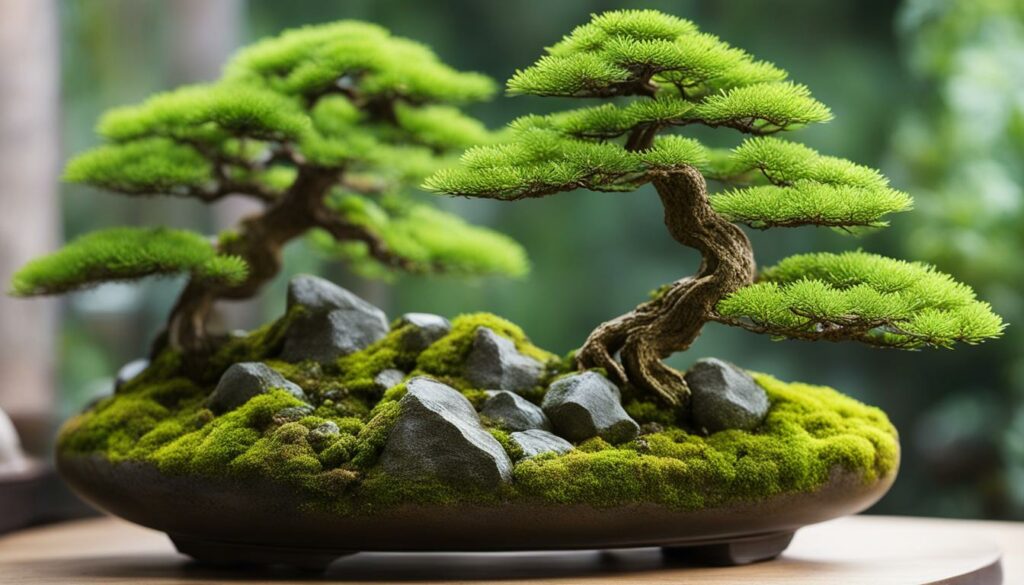
Selecting Suitable Tree Species
Creating a bonsai forest requires careful selection of tree species to establish a realistic and harmonious landscape. Not all tree species are suitable for Bonsai Styling Forest Planting, which requires a variety of species that thrive in this style of planting. When selecting tree species, keep in mind factors such as size, leaf shape, and growth characteristics to create a balanced and cohesive composition.
Some of the popular tree species that work well in forest plantings are:
| Tree Species | Size | Leaf Shape | Growth Characteristics |
|---|---|---|---|
| Japanese Maple | Small to Medium | Palmate or Dissected | Slow to Moderate |
| Eastern White Cedar | Small | Scale-like | Slow to Moderate |
| Bald Cypress | Medium to Large | Needle-like | Fast |
It’s important to select compatible species that will create a harmonious and balanced forest composition. Avoid trees with dominant growth characteristics that may outcompete other trees in the forest. A mixture of different shapes, sizes, and textures will create a more natural and visually appealing forest landscape.
Pro Tip: Research the native species of your region and consider incorporating them into your bonsai forest for a more authentic look.
Preparing the Trees for Planting
Before you begin your bonsai forest planting, it’s important to prepare your trees properly to ensure their health and successful growth. The steps involved in preparing your trees for planting include:
Pruning
Pruning is an essential part of preparing your trees for planting. Use sharp, clean pruning shears to trim away any dead or damaged branches. Be sure to also remove any unwanted branches that don’t contribute to the desired forest aesthetic.
Wiring
Wiring allows you to shape and manipulate your tree branches into the desired positions. Using pliable wire, carefully wrap the branches, taking care not to damage the bark. Avoid leaving wire on for too long, as it can cut into the branch and cause damage.
Repotting
When repotting your trees, choose a pot that is slightly larger than the tree’s current container to allow room for growth. Use well-draining soil that is specific to bonsai cultivation to ensure healthy root development.
By following these necessary steps, you can effectively prepare your trees for planting in a way that promotes their health and encourages successful growth.
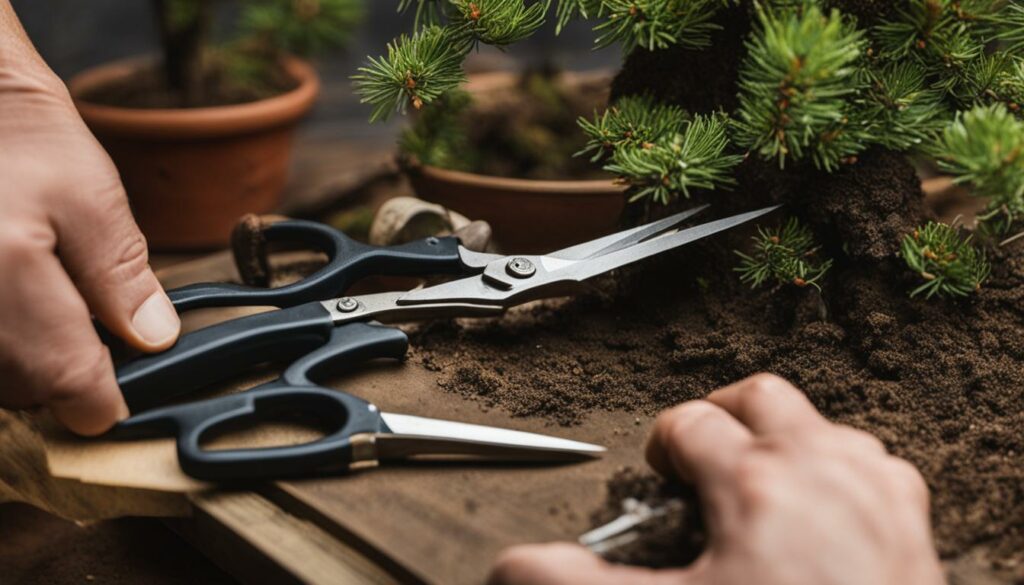
Creating the Forest Landscape
Creating a bonsai forest landscape is all about arranging and positioning the trees to achieve a natural and harmonious look. The goal is to mimic the feeling of a natural forest, where trees of different sizes and shapes grow together in a cohesive landscape. To achieve this effect, it’s important to consider both the placement and orientation of each tree.
Begin by selecting a focal point for your forest planting. This could be a larger or more distinct tree that you want to draw attention to, or a particular section of the planting that you want to highlight. Once you have your focal point, arrange the other trees around it to create a sense of depth and dimension within the planting.
Group planting is the key to creating a bonsai forest landscape. Place the trees close together, using different sizes and heights to create interest and variety. Avoid rigid symmetry, and instead aim for a more naturalistic look by staggering the heights and angles of the trees. Consider using rocks, moss, and other accent plants to create a more realistic forest landscape.
“When creating a bonsai forest landscape, think of each tree as a character in a story. Each tree has its own unique story to tell, and the landscape as a whole should feel like a cohesive narrative.” – Hiroki Miura, Bonsai Artist
When positioning the trees, consider the overall composition of the planting. Is the visual weight distributed evenly, or do some areas feel too heavy or sparse? Use your eye and intuition to create a sense of balance and harmony within the planting.
Remember to periodically step back and view the forest landscape from different angles to ensure that it looks balanced and realistic. Don’t be afraid to play around with the positioning until you achieve the desired effect.
Establishing Focal Points
Focal points help to create visual interest and depth within the bonsai forest landscape. A focal point could be a larger tree, a unique tree shape, or a grouping of trees that stand out from the rest.
To establish a focal point, place the selected tree or group of trees in a prominent position within the planting. Consider using accent plants or rocks to further draw attention to the focal point. This will help to create a sense of depth and dimension within the landscape.
Creating Depth and Dimension
Creating depth and dimension within the bonsai forest planting is essential for achieving a realistic and harmonious look. Use the principles of perspective to create the illusion of depth within the landscape.
Place the larger trees towards the back of the planting and the smaller trees towards the front. Angle tree branches towards the center of the planting to create the sense of depth and to draw the eye into the landscape.
Tips for Creating a Bonsai Forest Landscape
| Tip | Description |
|---|---|
| Arrange trees in groups | Group planting is essential for creating a bonsai forest landscape. Use different sizes and heights to create variety. |
| Use accent plants and rocks | Adding accent plants and rocks can help create a more realistic and naturalistic landscape. |
| Establish a focal point | Consider using a larger or unique tree, or a group of trees, as the focal point of the landscape. |
| Create depth and dimension | Use the principles of perspective to create the illusion of depth and to draw the eye into the landscape. |
Enhancing the Visual Appeal
Now that you’ve learned how to create a stunning bonsai forest, it’s time to enhance its visual appeal to make it look more realistic and captivating. Adding accent plants, rocks, and other natural elements can make a significant difference in creating a more lifelike and breathtaking landscape.
Start by choosing suitable accent plants that complement your forest planting. Select plants that are proportionate in size and have similar lighting and watering requirements. Consider adding low-growing groundcovers or small flowering plants to create an additional layer of depth and texture.
Add rocks and stones to replicate the look of a natural forest. You can use small pebbles or large rocks to create pathways or stepping stones throughout the landscape. Place them strategically to create the illusion of depth and perspective.
To make your miniature forest look more natural, you can create the illusion of age and weathering. Add a thin layer of moss to the surface of the soil and rocks to create a mossy, aged appearance. Use a fine brush to apply a small amount of diluted acrylic paint to highlight certain areas, creating the look of weathering, such as on rocks or tree bark.
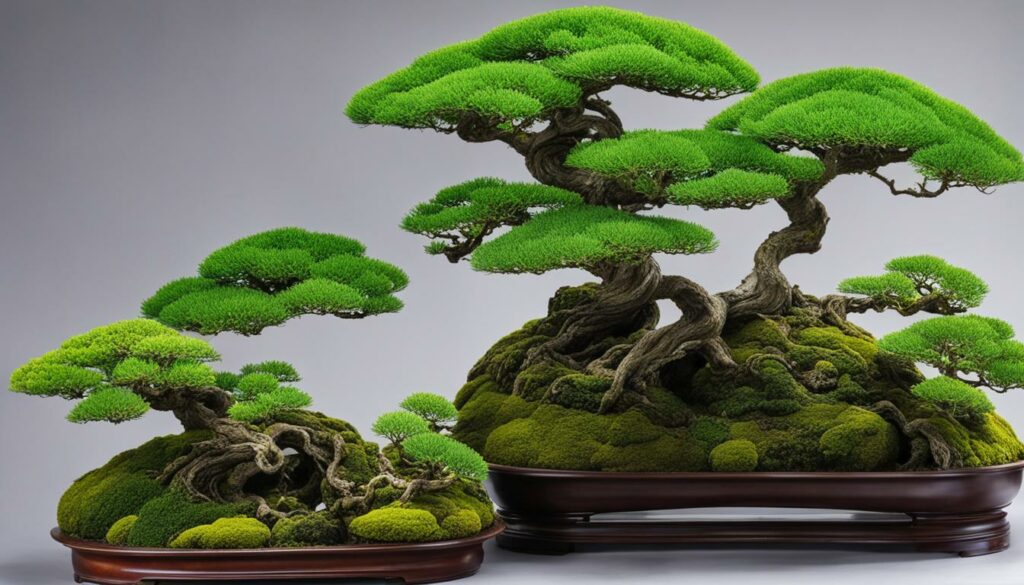
“By adding accent plants and natural elements, you can create the illusion of a real-life forest and elevate your bonsai to new heights.”
Nurturing and Maintaining Your Bonsai Forest
Now that your bonsai forest is planted, it’s important to give it proper care and attention to ensure its longevity and health. Here are some essential tips for caring for your bonsai forest:
- Watering: Bonsai trees need to be watered regularly, but not excessively. The soil should be kept moist, but not too wet. Check the soil every day to determine whether it needs watering. Use a watering can with a fine nozzle to avoid damaging the trees.
- Fertilizing: Feed your bonsai forest with a balanced fertilizer every two to four weeks during the growing season. Follow the package instructions for the proper amount of fertilizer to use.
- Pruning: Regular pruning is important for maintaining the shape and health of your bonsai forest. Remove any dead, damaged, or diseased branches. Trim back new growth to maintain the desired shape and size.
- Caring for multiple trees: When caring for multiple trees in a bonsai forest, it’s important to ensure that they don’t become overcrowded. Regularly inspect the trees and remove any that are not thriving or are competing for space.
By following these simple tips, you can ensure that your bonsai forest remains healthy and vibrant for years to come.
Troubleshooting Common Issues
While bonsai forest planting can be a rewarding and meditative experience, it’s not without its challenges. Here are some of the common issues that bonsai enthusiasts may encounter when creating and maintaining their miniature forests:
Pests and Diseases
Just like any other plant, bonsai trees are not immune to pests and diseases. However, because they are grown in small containers, they are more susceptible to infestations and infections. Some of the most common pests and diseases that affect bonsai trees include:
- Scale insects
- Aphids
- Caterpillars
- Fungal diseases
- Bacterial infections
To prevent and treat these issues, it’s important to regularly inspect your bonsai trees for signs of trouble. If you notice any unusual discoloration, growths, or insect activity, take action immediately. You may need to apply an insecticide or fungicide, prune affected foliage, or repot your tree in fresh soil to solve the problem.
Root Overcrowding
Because bonsai trees are grown in small containers, they are prone to root overcrowding over time. This can lead to stunted growth, nutrient deficiencies, and other health problems. To prevent root overcrowding, it’s important to regularly repot your bonsai trees every two to three years. When repotting, trim the roots to maintain a healthy balance between the root system and foliage.
Environmental Factors
The environment in which you grow your bonsai trees can have a significant impact on their health and growth. Some of the factors you should consider include:
- Light exposure
- Temperature and humidity levels
- Water quality and frequency
Make sure your bonsai trees are receiving the appropriate amount of light, water, and nutrients for their specific species. Consider using a humidifier or pebble tray to maintain consistent humidity levels, especially during dry winter months. And keep your trees in a location that is protected from extreme heat, cold, wind, and other environmental stressors.
Bonsai Styling Forest Planting Troubleshooting Tips
Here are some additional tips and tricks to troubleshoot common issues that may arise during the bonsai forest planting process:
“Prevention is always better than cure, so be vigilant and proactive in maintaining the health of your bonsai trees. Learn to recognize the signs of trouble and take action quickly to minimize damage and maximize their longevity.”
Adam Jones, Bonsai Forest Planting Enthusiast
Keep in mind that bonsai forest planting is an art that requires patience, dedication, and a willingness to learn and adapt. Don’t be discouraged if you encounter challenges along the way—use them as an opportunity to grow and expand your skills. With proper care and attention, your miniature forest can thrive for years to come.
Showcasing Your Bonsai Forest
Once your bonsai forest is thriving, it’s time to showcase it to the world! There are a variety of display options to choose from depending on your personal style and the size of your forest planting. Traditional display tables are a classic choice and come in a variety of styles and designs to complement your miniature landscape.
You can also get creative with innovative mounting methods, such as mounting on a slab of natural stone or creating a unique hanging display. Whatever method you choose, be sure to create a visually appealing display that showcases the beauty of your forest planting.
When photographing your bonsai forest, keep in mind the importance of capturing its natural beauty. Choose a neutral background that won’t compete with the colors and textures of your trees. Use natural lighting to ensure the colors are true to life, and experiment with different angles and perspectives to find the best shot.
Whether you’re displaying your bonsai forest at a show or sharing it on social media, take pride in your miniature masterpiece and enjoy the admiration of others.
Bonsai Forest Communities and Events
Join the community of Bonsai Styling Forest Planting enthusiasts to connect and share your passion for this beautiful art form. Whether you’re a seasoned pro or just starting, there are plenty of online communities, clubs, and events dedicated to Bonsai Forest Planting.
Participate in discussions with like-minded individuals and gain valuable insights into this unique art form.
Attend workshops and classes to learn from experienced Bonsai artists who specialize in the forest style. These classes provide an excellent opportunity to perfect your skills and learn new techniques to improve your creations.
Explore upcoming events and exhibitions dedicated to landscape bonsai, where you can showcase your Bonsai Forest Plantings and be a part of this thriving community.
Joining a Bonsai community is an excellent way to stay motivated, enhance your skills and create beautiful, living works of art. Join today and discover the magic of Bonsai Forest Planting.
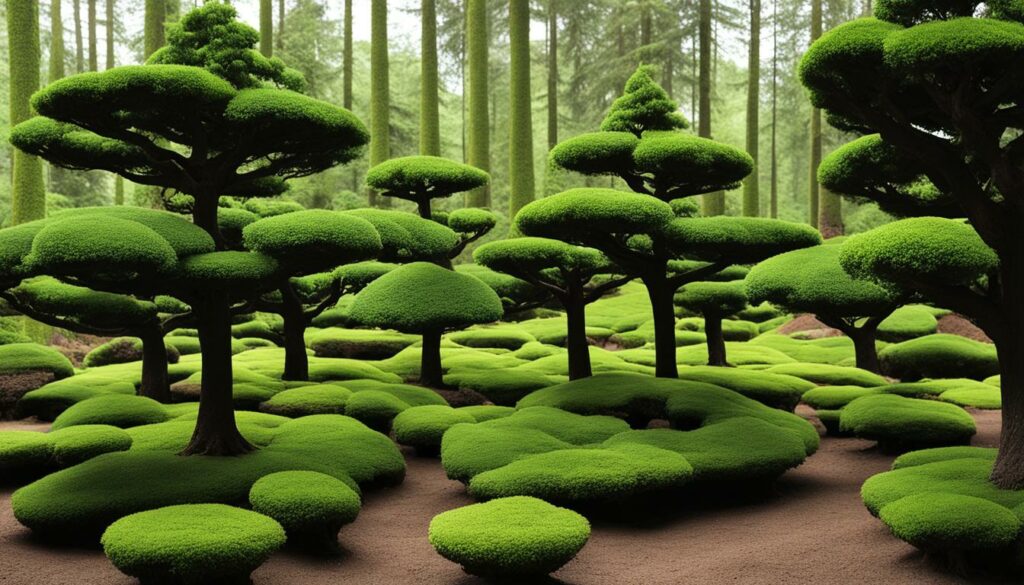
Exploring Bonsai Forest Plantings Around the World
Bonsai styling forest planting is a beloved art form, with enthusiasts and communities worldwide. Famous bonsai gardens and exhibitions showcase stunning forest plantings that inspire and captivate bonsai lovers. Exploring different cultural approaches to forest styling can offer invaluable insights and techniques that you can incorporate into your bonsai styling.
Famous Bonsai Gardens and Exhibitions
| Location | Name | Description |
|---|---|---|
| Japan | Bonsai Village | A picturesque village with an array of bonsai in stunning gardens |
| China | Bonsai Garden in the Yuyuan Garden | One of the oldest gardens in China and home to magnificent bonsai collection |
| United States | National Bonsai and Penjing Museum | A museum dedicated to these miniature marvels with a diverse collection of bonsai. |
| Brazil | Bonsai Diamond Garden | A beautiful garden with an emphasis on rare plant species. |
These gardens and exhibitions showcase how bonsai styling offers infinite possibilities for artistic expression, with the bonsai forests’ beauty transcending borders and cultures.
“Bonsai is peace, a connection of centuries past to eternity.” – John Yoshio Naka
John Yoshio Naka was a renowned American bonsai master. He promoted bonsai in the United States, and his artistry with forest plantings inspired bonsai enthusiasts worldwide.
Preserving the Beauty of Bonsai Forests
When caring for your bonsai forest planting, it’s essential to think about its long-term preservation. By taking the right steps, you can ensure that your miniature forest will endure for generations to come.
Succession Planning
One crucial aspect of preserving your bonsai forest is succession planning. Think about who will care for your trees after you’re no longer able to do so. Consider passing on your bonsai knowledge and love for the art to younger generations or finding a trusted caretaker who will continue your legacy.
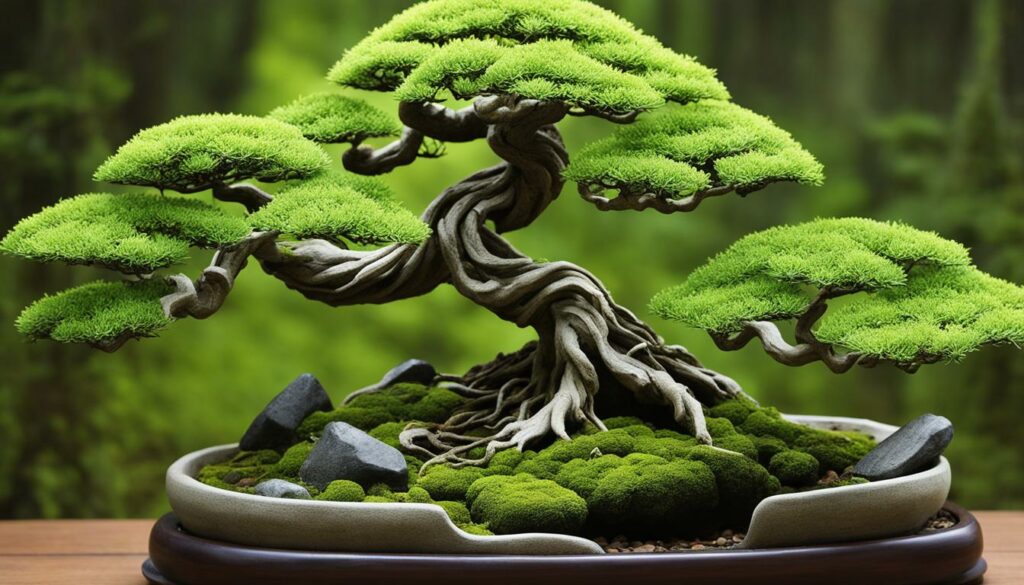
Long-Term Care and Maintenance
Bonsai trees can live for hundreds of years with proper care. Ensure the long-term health of your bonsai forest by monitoring its growth, pruning it regularly, and providing adequate water and sunlight.
Creating a Lasting Legacy
Bonsai forest planting is a true art form that requires patience, skill, and dedication. By preserving the beauty of your miniature forest, you are creating a lasting legacy that will inspire and captivate others for years to come.
Bonsai Forest Planting: A Meditation in Miniature
Creating a bonsai forest is not just an art form but also an opportunity for personal reflection and mindfulness. Taking the time to care for and cultivate your tiny woodland can bring a sense of peace and tranquility to your everyday life. As you shape and manipulate each tree, you’ll find yourself lost in the moment, fully present in the here and now. This type of meditative practice can have a calming effect, reducing stress and promoting a sense of well-being.
Each leaf and branch becomes a canvas on which you can express your creativity and artistic vision. Watching your bonsai forest grow and flourish over time is a rewarding and fulfilling experience. It’s a reminder that sometimes the smallest things can bring us the greatest joy.
Tips for Mindful Bonsai Forest Planting:
- Take your time and enjoy the process. Don’t rush or try to force the trees into a specific shape.
- Use the practice as an opportunity to slow down and be fully present in the moment.
- Experiment with different tree species and arrangements to find what works best for you.
- Practice patience and acceptance when your trees don’t turn out exactly as you planned.
- Remember that bonsai forest planting is a lifelong journey of learning and growth.
By incorporating bonsai forest planting into your daily routine, you can experience the many benefits of mindfulness and connect with the natural world in a profound way.
Cultivating Your Bonsai Styling Skills
Now that you’ve mastered the basics of Bonsai Styling Forest Planting, it’s time to expand and refine your skills. Through continued learning, experimentation, and artistic expression, you can create truly unique and captivating miniature landscapes. Here are some advanced techniques and concepts related to bonsai forest plantings to help you take your skills to the next level:
Master Group Planting
Group planting is a fundamental technique in Bonsai Styling Forest Planting. To create a natural forest feel, it’s important to understand how multiple trees relate to each other within the landscape. Study the interactions between trees in a real forest, considering factors such as light, water, and soil. Apply this knowledge to your bonsai forest, carefully selecting and positioning trees to create a cohesive composition.
Embrace the Forest Style
The forest style of bonsai is all about creating a miniature natural forest landscape. To achieve this style, pay attention to the flow and lines of your planting. Consider how trees of different sizes, shapes, and colors can work together to create a harmonious and balanced composition. Pay particular attention to the placement of the tallest tree, which should anchor the planting and draw the viewer’s eye into the forest.
Experiment with Accent Plants
Adding accent plants to your bonsai forest planting can help create a more realistic and polished look. Choose plants that complement your tree species, such as groundcovers, ferns, or mosses. Consider using hard materials such as rocks or stones to enhance the natural feel of the landscape. Placement of accent plants can also help create visual interest and depth within the planting.
| Bonsai Styling Forest Planting Techniques | Description |
|---|---|
| Nebari Development | Nebari refers to the visible surface roots of a bonsai tree. Developing a strong and wide nebari is essential to the overall aesthetic of a bonsai forest planting. |
| Layering Techniques | Layering is a propagation technique that involves rooting a branch while it is still attached to the parent tree. This technique can be used to create new trees that are already in the desired forest style. |
| Deadwood Techniques | Deadwood techniques involve creating hollowed-out or dead areas on a tree trunk to mimic natural aging and weathering. This technique can be used to create a more realistic and aged look for your bonsai forest planting. |
Nurture Your Trees with Careful Maintenance
Maintaining the health of your trees is critical to the longevity and beauty of your bonsai forest planting. Regular pruning, wiring, and feeding are necessary to keep your trees healthy and balanced. Pay attention to the unique requirements of each tree species in your planting and adjust your care accordingly.
Creating a bonsai forest is a rewarding and ongoing journey. Mastering the art of forest planting requires patience, dedication, and a willingness to learn. Continue to explore the techniques and concepts of Bonsai Styling Forest Planting, challenge yourself to experiment and create, and enjoy the peace and tranquility that comes from cultivating your miniature forest landscape.
Conclusion
Embarking on the journey of Bonsai Styling Forest Planting offers a delightful opportunity to create miniature landscapes that mimic the beauty and tranquility of a natural forest. Through understanding the principles and techniques of this style of planting, you can master the art of creating a living, breathing work of art. Whether you are a seasoned bonsai enthusiast or a beginner, the art of forest planting offers endless possibilities for creativity and self-expression.
Remember to choose suitable tree species, prepare the trees for planting, and create a harmonious and balanced composition. With proper care and maintenance, your miniature forest will thrive and become a source of peace and tranquility for you and your loved ones.
Continue to cultivate your Bonsai Styling Forest Planting skills by exploring advanced techniques and concepts related to group planting and forest style. Join online communities and clubs dedicated to bonsai forest plantings to connect with fellow enthusiasts, participate in workshops, and learn from experienced bonsai artists who specialize in the forest style.
Let the magic of the forest unfold before your eyes as you immerse yourself in the art of Bonsai Styling Forest Planting.
FAQ
What is bonsai forest planting?
Bonsai forest planting is a technique where multiple bonsai trees are planted together in a group to create a miniature forest landscape. It aims to imitate the look and feel of a natural forest setting.
How is forest style bonsai different from other bonsai styles?
Forest style bonsai is characterized by the planting of multiple trees in a group, creating a cohesive landscape. This style aims to replicate the appearance of a mature forest, with varying heights and densities of trees.
What tree species are commonly used in forest style bonsai?
Common tree species used in forest style bonsai include pines, junipers, maples, and elms. These trees are chosen for their ability to thrive in close proximity and their aesthetic appeal in a group planting.
How do you create depth and dimension in a bonsai forest landscape?
To create depth and dimension, taller trees are typically positioned toward the back of the arrangement, while shorter trees are placed toward the front. This arrangement allows for a sense of perspective, making the forest appear larger and more realistic.
How do you maintain a bonsai forest planting?
Proper care and maintenance are essential for the health of a bonsai forest. This includes regular watering, fertilizing, and pruning. It’s important to monitor the growth of individual trees to prevent overcrowding and maintain a balanced composition.
What are some common issues that bonsai forest plantings face?
Common issues with bonsai forest plantings include pests and diseases specific to bonsai, root overcrowding, and the need for regular shaping and pruning. It’s crucial to stay vigilant and address these issues promptly to ensure the long-term health of the forest.
How can I display my bonsai forest?
Bonsai forests can be displayed on traditional bonsai display tables or mounted on unique platforms. Experiment with different display methods to showcase the beauty of your forest arrangement. Ensure that the display area provides suitable light and temperature conditions for the trees.
Are there online communities and events dedicated to bonsai forest plantings?
Yes, there are online communities, clubs, and events where bonsai enthusiasts gather to share their knowledge and showcase their bonsai forests. Participating in these communities can provide opportunities to learn from experienced bonsai artists and connect with fellow enthusiasts.
How can I preserve the beauty of my bonsai forest for the future?
To preserve the beauty of your bonsai forest, it’s important to have a succession plan in place. This includes sharing your bonsai knowledge with others and ensuring that someone is designated to care for the forest after you. Regular maintenance and documentation will also help ensure its longevity.
What are the meditative aspects of bonsai forest plantings?
Bonsai forest plantings provide an opportunity for personal reflection and mindfulness. The process of tending to the trees and creating a miniature world can be a calming and meditative experience. It allows for a connection with nature and a sense of tranquility in everyday life.
How can I further develop my bonsai styling skills?
To cultivate your bonsai styling skills, continue learning and experimenting with different techniques. Explore advanced concepts related to bonsai forest plantings and seek inspiration from renowned artists. Embrace artistic expression and let your creativity shine in creating unique and captivating miniature landscapes.
